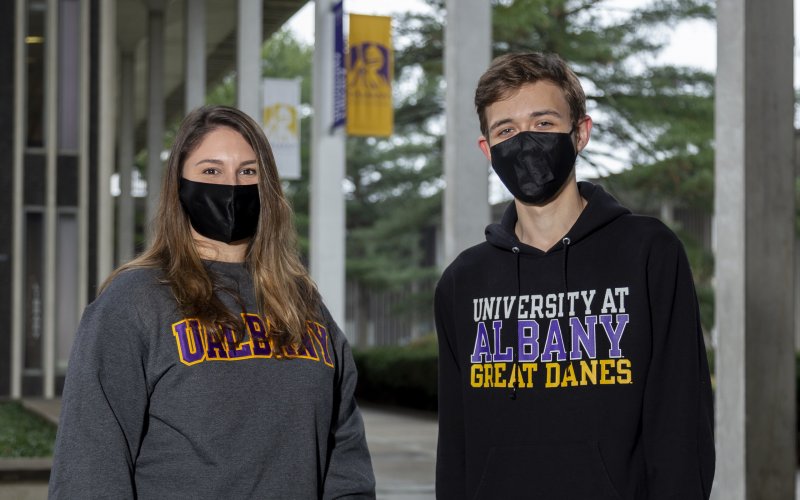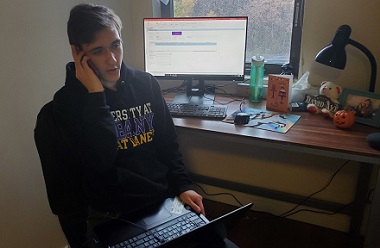UAlbany Student Support Team Works to Stop Spread of COVID-19

ALBANY, N.Y. (Nov. 3, 2020) – During a semester full of unprecedented challenges, volunteers across campus have played an instrumental role in allowing the University to safely remain open for in-person activities – including a group of 13 interdisciplinary students.
Known as UAlbany’s Student Support Team (SST), the group has dedicated nearly two months to contacting individuals whose saliva sample was part of a COVID-19 campus surveillance pool test that is presumed positive or who have been exposed to someone who has tested positive.
That phone call can make the difference in preventing an outbreak.
“The numbers show that UAlbany’s COVID-19 response has created a safe environment. Our students are statistically safer on campus than they are off,” said Derek Morrison, special assistant to the director at UAlbany’s National Center for Security and Preparedness (NCSP) and SST manager. “The SST is playing an integral part in this response and we wouldn’t be successful without them.”
On the Front Lines
The SST, which is a component of UAlbany’s Incident Management Team (IMT), was launched through a partnership between the NCSP and School of Public Health in an effort to connect with students who are associated with a positive test as quickly as possible.
The team is an intentional mix of undergraduate and graduate students across three schools – the College of Emergency Preparedness, Homeland Security and Cybersecurity, School of Public Health and School of Social Welfare. Together, the group offers a diverse set of skills and experience levels.
After going through extensive onboarding, which included completion of the Johns Hopkins contract-tracer course and a number of group team trainings, the SST students have since collectively spent hundreds of hours working closely with the University’s IMT to offer students guidance and support.
David Skorodinsky, a senior Informatics major, built the team’s internal call log and case database.

“When [COVID-19 cases] first started to spike, there was a sense of what can be done to make this a little better? Through the SST, I have found a way to utilize my technology skills, while also gaining real crisis management experience.”
Along with initial contact, the SST is also reaching out daily to students in the midst of their mandated quarantine or isolation period for wellness check-ups. Taylor Perre, a second-year dual master’s student in Social Work and Public Health, led SST’s mental health training during the team’s onboarding process.
“It’s tough to tell someone they have to spend 10 or 14 days alone in a room. They can’t take a break or even go outside,” said Perre. “It’s important they hear from us and are made aware of all the virtual resources that are available to them. We want to help make this process a little easier for them.”
Keeping Campus Safe
Of the nearly 16,000 individual campus saliva samples that have been analyzed at The RNA Institute, in collaboration with the School of Public Health, the presumed positivity rate is less than 0.5 percent.
Eliana Duncan, a doctorate student in Epidemiology and Biostatistics, said that while contacting students is often difficult, she believes their work is making a real difference.
“Generally, students understand the bigger picture; that what we’re telling them to do will help keep themselves and the campus community safe,” Duncan said. “It’s our job on these calls to remain calm and make sure we’re relaying all of the necessary information.”
Testing is now being conducted at a weekly frequency for all students and employees who are on campus in any capacity. The SST plans to continue operation through at least next semester or until they are no longer needed.
More information on the University’s pooled surveillance testing program can be found on its website.




